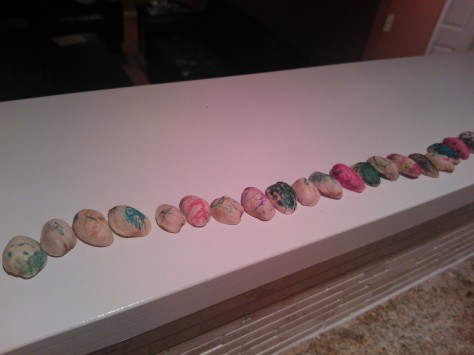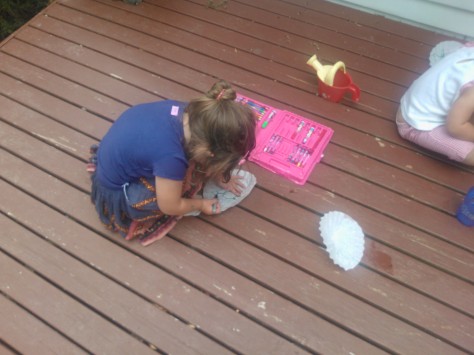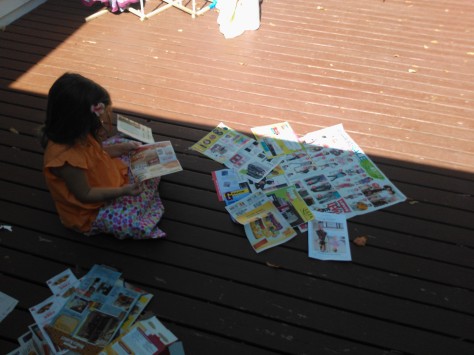 We have been in the US for 6 weeks but our furniture and the majority of the childrens’ toys will not arrive for another month. During this period we have become experts at finding things to play with from around the house. We brought a small selection of basic toys – colouring pencils, scissors, a glue stick, paper, a ball and a few books, other than that we have made our own fun. The other children in the street think it is strange to come to a house with no toys but if I am honest I don’t think there is a great deal that the children have missed.
We have been in the US for 6 weeks but our furniture and the majority of the childrens’ toys will not arrive for another month. During this period we have become experts at finding things to play with from around the house. We brought a small selection of basic toys – colouring pencils, scissors, a glue stick, paper, a ball and a few books, other than that we have made our own fun. The other children in the street think it is strange to come to a house with no toys but if I am honest I don’t think there is a great deal that the children have missed.
I have been meaning to write a post about some of the household objects that we have played with for some time, but an article that I read yesterday made me look at it from a different perspective. Sadaf Shallwani’s article Questioning Play and Child-Centred Approaches discusses her experience of teaching children in Pakistan. Here, childrens’ learning was not built around pretend play but came from real experiences. Children would not learn to cook in a pretend kitchen but would be taught to use real kitchen utensils in a safe manner.
She also questions Western notions of child-centred education. Early educators try to see the world through a child’s eyes and provide child-sized furniture and objects. The value of using real objects is recognised in many highly-acclaimed pre-schools. The schools of Reggio Emilia use many real-life scenarios as the basis for their projects and a colleague who visited the schools was surprised to find the children climbing onto adult-sized chairs and tables. A key philosophy of the Reggio Schools is the belief that children are capable. With this in mind the teachers help the children to use real tools and objects. Similarly in the Danish Forest Schools that another colleague visited, young children were taught to use real tools and knives to whittle sticks and were free to roam in the woodlands and on the beach and trusted to return at the sound of a whistle.
 I remember as a child using real objects from my kitchen to play shops and tea parties. Toy versions of everything are so readily available these days that it is easy to be drawn into the need to buy more and more. It is also easy to fall into the trap of believing that children need adapted versions of things for their own safety. If we trust them with real things, spending time explaining the risks and demonstrating how to use them properly, children are more safety-conscious than those who do not understand the danger of the real objects.
I remember as a child using real objects from my kitchen to play shops and tea parties. Toy versions of everything are so readily available these days that it is easy to be drawn into the need to buy more and more. It is also easy to fall into the trap of believing that children need adapted versions of things for their own safety. If we trust them with real things, spending time explaining the risks and demonstrating how to use them properly, children are more safety-conscious than those who do not understand the danger of the real objects.
Not having toys has been a very useful exercise. We have used things from around the house and recycled boxes and paper to create an Olympics and a mud kitchen, we have borrowed books from the library and we have played ball games and skipping.
Here are a few other objects we have utilised:-
Pistachio Nut Shells
 We saved the shells from our pistachio nuts and the girls had great fun decorating them. We coloured them so that we could make flowers and patterns and decorated some to look like ladybirds and other bugs. My 3-year-old chose some pebbles from the garden to decorate as they weren’t quite so fiddly for her small hands.
We saved the shells from our pistachio nuts and the girls had great fun decorating them. We coloured them so that we could make flowers and patterns and decorated some to look like ladybirds and other bugs. My 3-year-old chose some pebbles from the garden to decorate as they weren’t quite so fiddly for her small hands.
 On another occasion I gave my 1-year-old the tub of shells along with a pan, spoon and a number of containers. She enjoyed scooping them and transporting the shells from one container to another. She also liked the sound they made as they fell onto the floor. As she walked they stuck to her feet so I showed her how to pick them up with her toes which she thought was very funny.
On another occasion I gave my 1-year-old the tub of shells along with a pan, spoon and a number of containers. She enjoyed scooping them and transporting the shells from one container to another. She also liked the sound they made as they fell onto the floor. As she walked they stuck to her feet so I showed her how to pick them up with her toes which she thought was very funny.
Coffee Filters
 I remember doing this activity in science lessons at school. I gave the girls felt tip pens and coffee filters and asked them to draw patterns on them.
I remember doing this activity in science lessons at school. I gave the girls felt tip pens and coffee filters and asked them to draw patterns on them.
When they had finished they were given a small pot of water and I showed them how to drip it on to the paper creating rainbow colours.
Paper
We kept newspapers and magazines with a view to making papier-mache. The girls would like to enter a local parade on Saturday and I suggested they might be able to make papier-mache masks.
My 3-year-old had other ideas. She decided to spread the paper across the floor. ‘I’m making a bed’ she said. 
She had also made other things for her house by sticking boxes together
I’ve often felt that my house has been taken over by toys that the children hardly ever play with, so I’m not particularly looking forward to them all arriving. I hope that being creative with household objects will help us all to think about what we could use instead of buying yet another toy and maybe I can keep most of the toys in their boxes when they arrive.



Hi! Stopping by from MBC. Great blog!
Have a nice day!
LikeLike